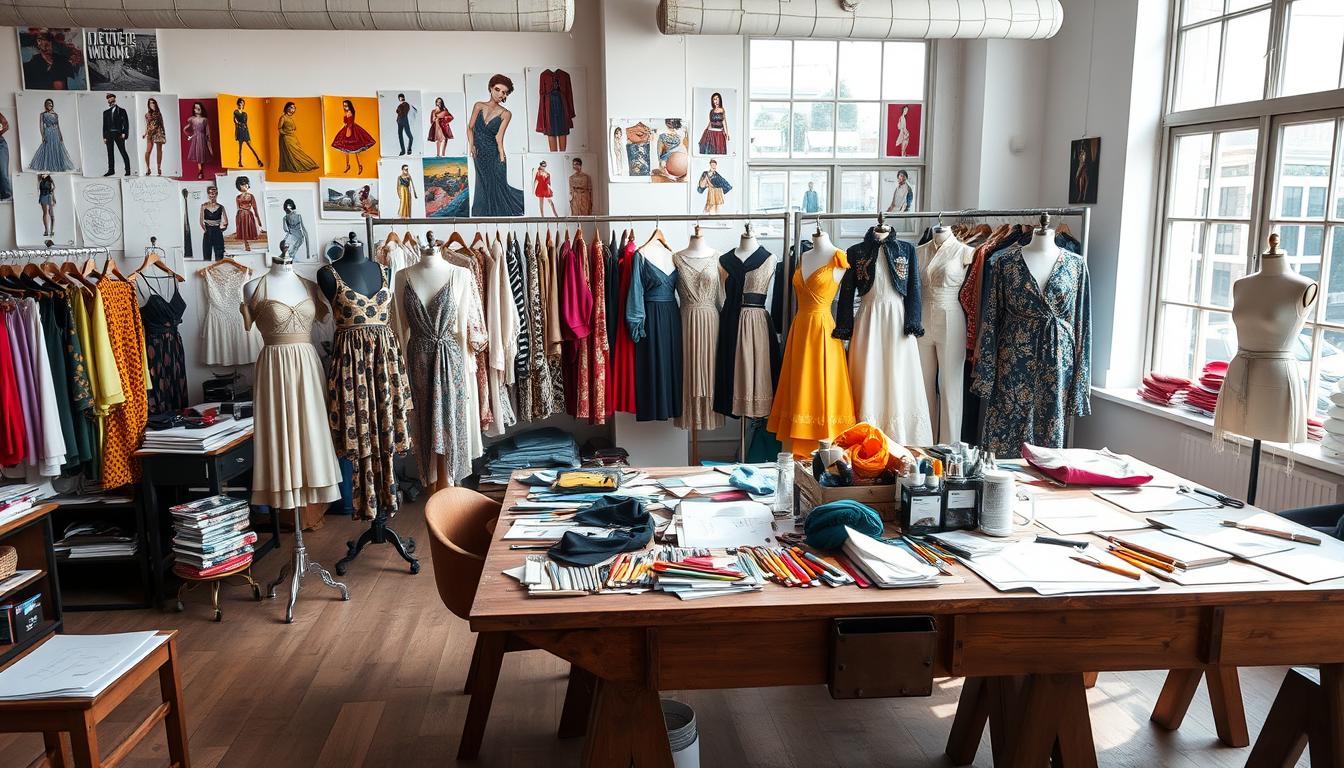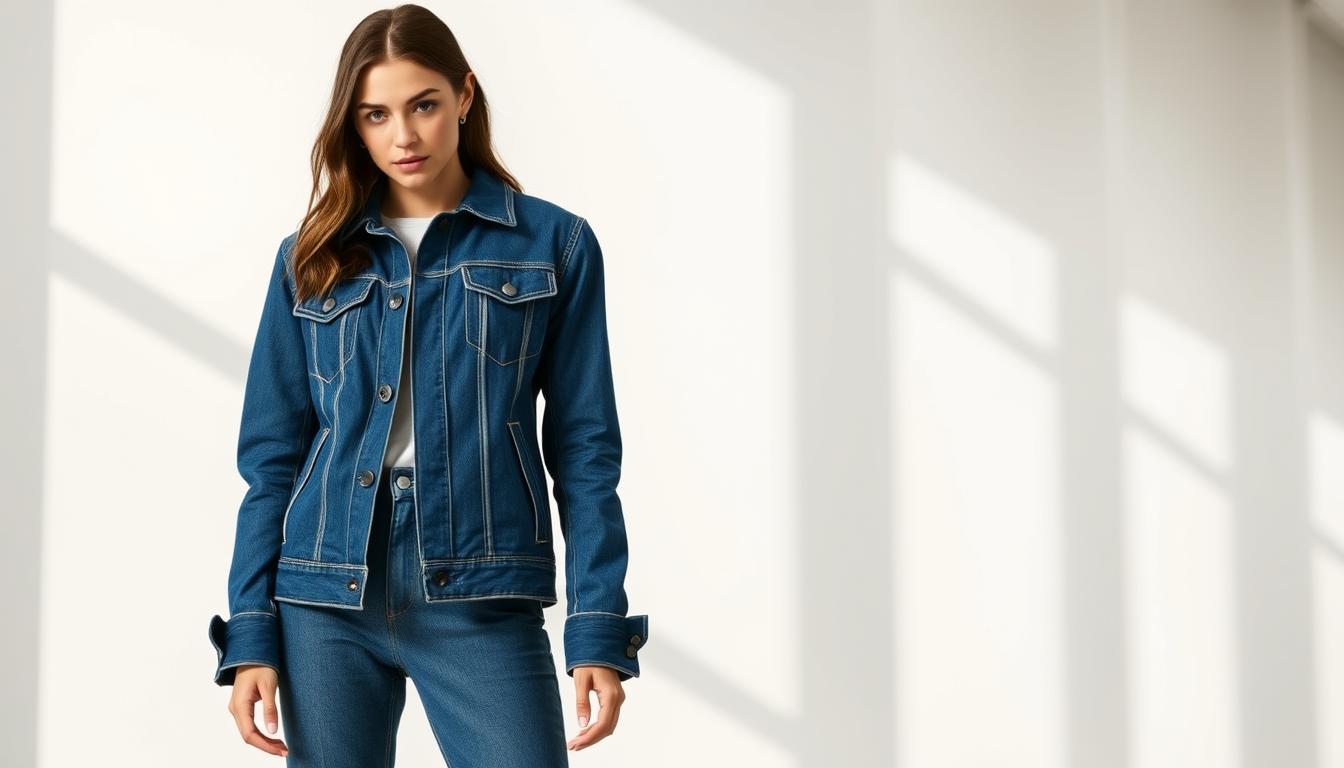The fashion world is full of jobs for those who love design and textiles. It covers everything from high-end fashion to eco-friendly clothes. This field lets you turn your creative ideas into a real career.
Fashion designers are key in making clothes, accessories, and shoes for fashion shows and everyday wear. You can be a garment, accessory, or costume designer. The fashion industry has many ways for you to use your artistic and technical skills.
Key Takeaways
- The fashion industry offers diverse career paths, from haute couture to sustainable fashion.
- Fashion designers create original clothing, accessories, and footwear, working on everything from initial sketches to final production oversight.
- Opportunities in the fashion industry extend beyond design, including roles in fashion merchandising, retail management, journalism, photography, styling, and marketing.
- Gaining real-world experience through internships and building a strong portfolio are crucial steps in pursuing a fashion design career.
- Employers seek fashion designers with technical production knowledge, strong visualization skills, and exceptional interpersonal and communication abilities.
What is Fashion Design?
Fashion design is the art of making clothes and accessories that look good and work well. It’s about creating garments that match current trends and styles. Fashion designers help people show their style and identity through what they wear.
The Essence of Fashion Design
Fashion design mixes creativity, technical skills, and knowledge of fabrics and trends. Good designers have a unique style and can make their ideas into real clothes. They must keep up with what people want and predict new trends.
Key Skills and Attributes
- Creativity and Innovation: Designers need to think new and try out fresh ideas.
- Technical Drawing and Pattern-making: Knowing how to sketch and make patterns is key to making clothes.
- Fabric and Material Knowledge: Understanding fabrics is important for making clothes that look good and feel comfortable.
- Trend Awareness: Keeping up with fashion trends helps designers make clothes that people want to wear.
Fashion design is a dynamic field with many fashion design career opportunities and textile design positions. It requires creativity, technical skills, and knowledge of the industry.
“Fashion is not something that exists in dresses only. Fashion is in the sky, in the street, fashion has to do with ideas, the way we live, what is happening.”
– Coco Chanel
Types of Careers in Fashion Design
The fashion world has many career paths beyond just being a fashion designer. You can work in apparel design, accessory design, or even costume design. There are lots of options to choose from.
Fashion Designer
Fashion designers are the ones who create clothing lines. They think up designs, pick out fabrics, and manage the making of clothes. They might focus on different types of clothing, like women’s, men’s, or kids’ wear.
Accessory Designer
Accessory designers make items that go with outfits. They design bags, shoes, jewelry, and more. They need to pay close attention to details and keep up with the latest trends.
Costume Designer
Costume designers create clothes for movies, plays, and TV shows. They work with directors, actors, and others to make costumes that fit the character and the show’s look.
| Role | Average Salary | Key Skills |
|---|---|---|
| Fashion Designer | $87,210 |
|
| Accessory Designer | $54,470 – $101,700 |
|
| Costume Designer | $54,470 – $101,700 |
|
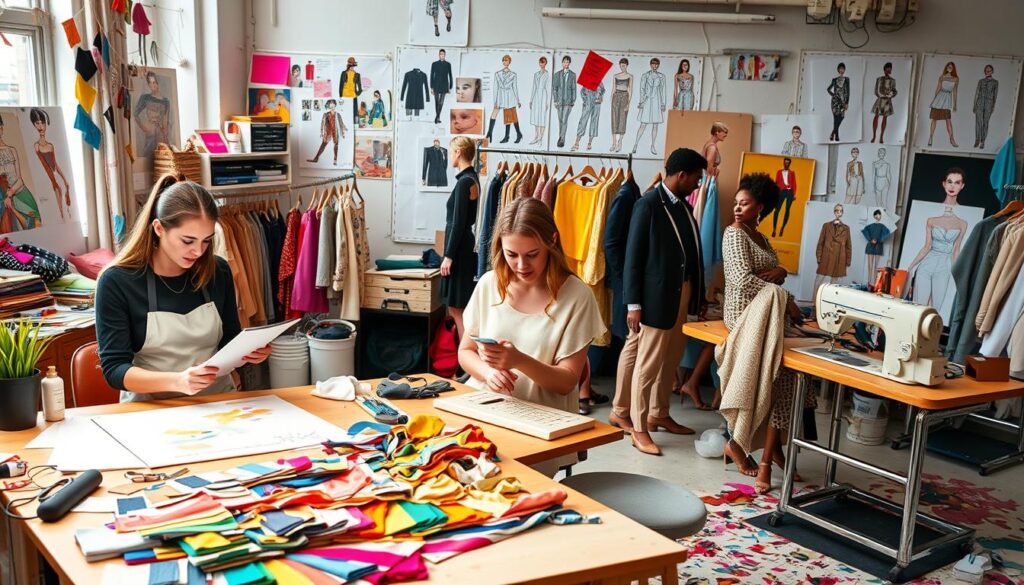
The fashion industry has many career paths, from apparel design to costume design. Each one needs different skills and qualities. This lets aspiring designers find and follow their creative dreams.
Educational Paths for Aspiring Designers
Getting into the fashion design world takes time, but education is key. Students often get associate or bachelor’s degrees at top schools like the Fashion Institute of Technology (FIT), Parsons School of Design, or Savannah College of Art and Design.
Fashion Design Degree Programs
A bachelor’s degree in fashion design is the norm. It teaches design basics, technical skills, and industry knowledge. Schools like Drexel University and Pratt Institute give students real-world experience in fashion industry jobs and clothing manufacturing careers.
Short Courses and Workshops
Short courses and workshops are great for those who want flexible learning. Places like the Fashion Institute of Design & Merchandising (FIDM) offer fashion industry jobs and clothing manufacturing careers programs. They help students learn specific skills and keep up with trends.
Online Learning Options
Today, online learning is also an option. It lets students access fashion design courses and resources easily. This is perfect for those with busy lives or who prefer learning at their own pace, helping them get into fashion industry jobs and clothing manufacturing careers.
No matter the path, start exploring fashion design early. Gain as much experience as you can through internships and networking. With hard work and a love for design, you can land a great fashion industry job or clothing manufacturing career.
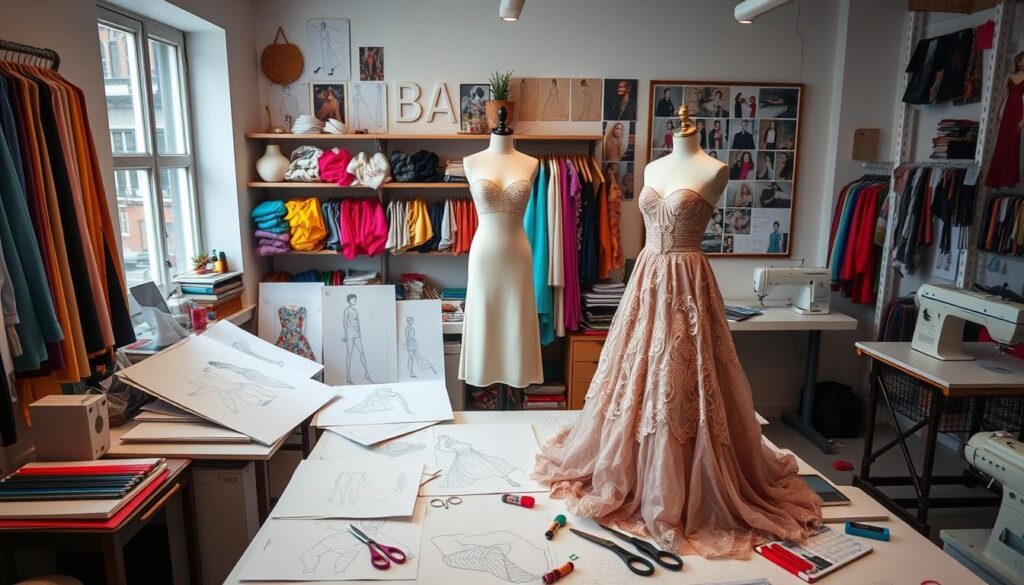
Essential Skills for Fashion Designers
The fashion world has changed a lot. It now combines art, business, tech, and caring for the planet. To succeed, designers need both creative and technical skills.
Creativity and Innovation
Creativity and new ideas are key in fashion design. Designers must see beauty and create unique designs. They use their skills to make clothes that stand out.
Technical Skills
Designers also need technical skills. They should know how to use computer programs, make patterns, and sew clothes. Paying attention to details is crucial for high-quality fashion.
Business Acumen
Designers must see their work as more than just making clothes. They need to know about money, marketing, and how to sell their designs. Working well with others is also important.
The fashion world keeps changing fast. Designers must keep up with new trends and tech. Using new tools and caring for the planet are important for the future.
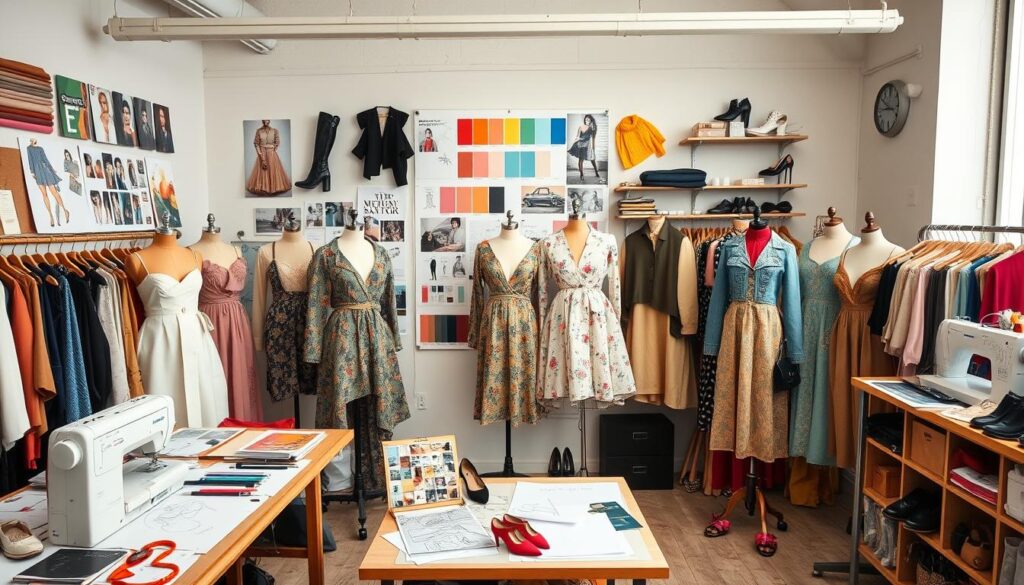
To do well in fashion, designers need talent, skills, business smarts, and a green approach. By focusing on these areas, they can have a fulfilling career in this exciting field.
Where to Find Job Opportunities in Fashion
The fashion world has many jobs, from designing clothes to managing stores. If you’re starting or changing careers, it’s key to know where to look for these jobs.
Major Fashion Hubs
The top fashion cities are New York, Paris, Milan, and London. These places have many fashion companies, design studios, and stores. If you want to work in fashion, try to find jobs in these cities. It’s a great way to meet people and find your dream job.
Online Job Portals
The internet is also a great place to find fashion industry jobs and fashion merchandising opportunities. Sites like FashionUnited, Glassdoor, and Indeed list many fashion jobs. They have jobs for all levels, from beginners to top executives.
Networking and Internships
Having a strong network and internships can really help in fashion. Go to fashion events, shows, and meetings to meet people. Internships can lead to full-time jobs, giving you experience and connections.
“The fashion industry is all about relationships. Networking and internships are essential for breaking into this competitive field.” – Jane Doe, Fashion Recruiter
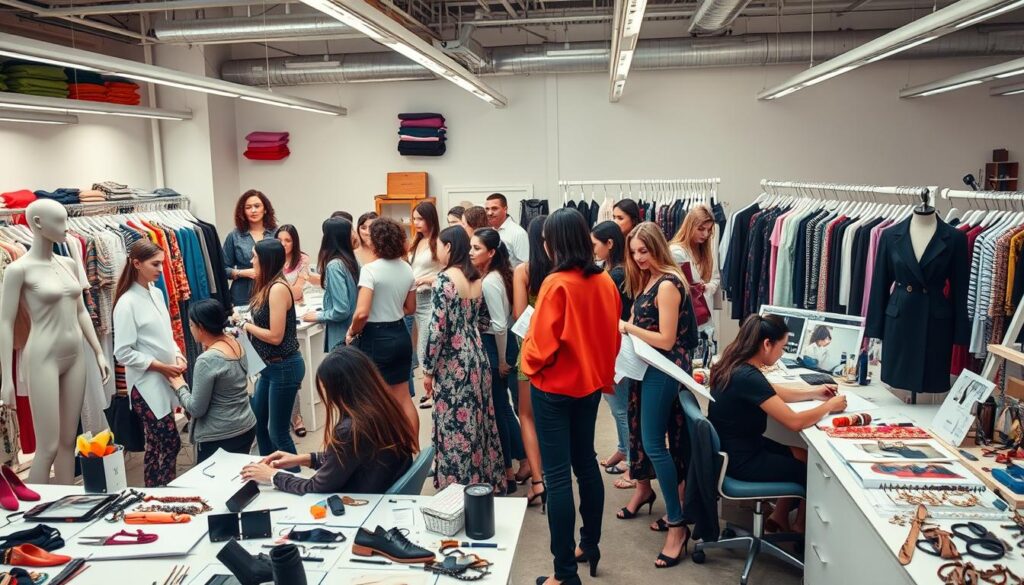
The fashion world is tough, but with the right approach, you can find your perfect fashion industry job or fashion merchandising opportunity. Focus on major fashion cities, use online resources, and network well.
The Role of Fashion Shows and Competitions
Fashion shows and design competitions are key in the fashion world. They help new designers show their talent, meet industry pros, and grow their careers. These events are great for those who love fashion to share their ideas and get noticed.
Importance of Fashion Shows
Fashion shows are the heart of the fashion world. They let designers show off their new designs. These events help designers meet buyers, media, and customers, which is great for their careers.
Being part of fashion shows can lead to big opportunities. Designers can find new partners, get exclusive deals, and even land jobs in the fashion world.
How Competitions Can Propel Your Career
Design competitions are also important for new designers. They offer a chance to get noticed, get money, and make important connections. Winning or doing well in a big competition can really help a designer’s career.
It can make them more famous, attract more clients, and even get them job offers. The fashion world is always changing, and designers who take part in shows and competitions have a big advantage. They can grow their careers, meet new people, and succeed in the fashion industry.
“Fashion is not something that exists in dresses only. Fashion is in the sky, in the street, fashion has to do with ideas, the way we live, what is happening.” – Coco Chanel
Building a Professional Portfolio
For those in fashion styling and footwear design, a strong portfolio is key. It shows off your skills, creativity, and design style. Whether you’re new or experienced, a good portfolio can impress employers or clients.
What to Include in Your Portfolio
Your portfolio should highlight your best work. This includes:
- Sketches and technical drawings
- Photographs of your designs
- Mood boards and concept presentations
- Digital designs made with software like Adobe Illustrator or InDesign
Focus on your latest and most relevant projects. Recruiters usually don’t look at work from more than 10 years ago. For fast-fashion, show how your designs meet market needs. For luxury brands, highlight your creativity and market savvy.
Tips for Presenting Your Work
Here are some tips for presenting your portfolio:
- Make a digital or online portfolio for a dynamic showcase.
- Fill every page to look polished and professional.
- Use photos of your designs on models for a better look.
- Organize your portfolio in a way that’s easy to follow and looks good.
- Get inspiration from fashion magazines, social media, and Pinterest to make your portfolio stand out.
A well-made portfolio can boost your chances in the fashion industry. It shows your skills, creativity, and industry knowledge. This can leave a lasting impression on employers or clients.
| Portfolio Length Recommendation | Ideal Portfolio Length |
|---|---|
| Fashion Designer Portfolio | 10-13 pages |
Freelancing vs. Corporate Employment
The fashion industry offers many career paths. You can choose between the stability of a job or the freedom of freelancing. It’s important to think about what each option offers to find the best fit for you.
The Allure of Freelancing
Freelancing in fashion is tempting. It offers creative freedom and control over your schedule. Freelance fashion designers can set their own rates, choose projects, and work on their terms. This is great for those who want a better work-life balance or to follow their unique design vision.
But freelancing has its challenges. It can be hard to find steady clients, manage tasks, and make sure you get paid. You need to be good at marketing, negotiating, and handling money matters.
The Advantages of Corporate Employment
Working for a fashion house has its benefits. It offers a steady paycheck, resources, and chances to work with experienced people. This helps with learning and networking. It’s good for those who want support and resources from a well-known brand.
But, corporate jobs might limit your creativity and flexibility. You might have to change your ideas to fit the brand’s style. Work hours can be long, and deadlines tight. Your choice depends on what you value most in your career.
Balancing the Best of Both Worlds
Some designers mix freelancing with a part-time job. This way, they get a steady income and still have time for personal projects or their own brands. This mix offers stability and creative freedom.
Choosing between freelancing and a job depends on your goals and preferences. By weighing the pros and cons, you can find the path that suits you best.
| Freelancing | Corporate Employment |
|---|---|
|
|
Staying Updated with Industry Trends
In the fast-paced world of fashion, keeping up with trends is key to success. Whether you dream of being a fashion designer, textile artist, or working in fashion merchandising opportunities or textile design positions, learning never stops. It’s the secret to excelling in this field.
Importance of Continuous Learning
Fashion is always changing, with new styles, materials, and tech popping up all the time. To succeed, fashion pros must keep learning and sharpen their skills. Workshops, seminars, and industry events are great for learning and networking.
Following Fashion Publications and Influencers
To stay on top of fashion trends, connect with top fashion publications, blogs, and influencers. From high-end mags to online platforms, these sources are full of info and inspiration. Following trendsetters helps you understand the market and spot new chances.
Trend forecasting is crucial for designers and merchandisers. It lets them predict and meet consumer needs. By staying informed and flexible, fashion pros can thrive in this fast-changing world.
| Continuous Learning Strategies | Benefits |
|---|---|
| Attending workshops and seminars | Gain industry-specific knowledge and skills |
| Engaging with fashion publications and influencers | Stay updated on trends and market insights |
| Participating in fashion events and networking | Build connections and unlock new opportunities |
| Pursuing ongoing education and certifications | Enhance credentials and demonstrate expertise |
“In the fashion industry, the only constant is change. Staying ahead of the curve requires a relentless commitment to continuous learning and adaptation.”
Future Trends in Fashion Design Careers
The fashion world is always changing, and those who want to be fashion designers need to keep up. Sustainability and technology are key areas to watch. They are shaping the future of fashion design careers.
Sustainability in Fashion
Sustainability is now a big deal in fashion. Eco-friendly materials and ethical production are must-haves. People who know how to make fashion sustainable are in demand.
Jobs in recycling, upcycling, and finding sustainable materials are growing. These roles are important for a greener fashion industry.
Technology and Innovation
Technology is changing fashion, opening up new career paths. Designers who know about 3D printing, AR, and VR are wanted. Luxury brands are using virtual spaces, making tech skills in fashion very valuable.
AI and data analytics are also big in fashion. They help with trend forecasting and managing supply chains. Designers need to learn to make decisions based on data.
To do well in fashion design, you need to be open to new things. Stay updated on trends and keep learning. This way, you can succeed in the changing world of fashion design career opportunities and apparel design roles.
| Emerging Trend | Impact on Fashion Design Careers |
|---|---|
| Sustainable Fashion | Increased demand for roles in recycling, upcycling, and sustainable material sourcing |
| AI and Data Analytics | Need for professionals with expertise in data-driven decision-making and collaboration with data scientists |
| 3D Printing and Customization | Growth in careers focused on 3D printing, modular design, and personalized fashion |
| Virtual and Augmented Reality | New opportunities in digital fashion design and virtual retail experiences |
| Inclusive and Diverse Design | Increased focus on inclusive design and diverse representation in leadership roles |
“The future of fashion design is not just about creating beautiful garments, but about innovating sustainable solutions and embracing technological advancements to deliver unique, personalized experiences for consumers.” – Jane Doe, Sustainability Consultant
Conclusion: Your Journey in Fashion Design
A career in fashion design is full of creativity and new ideas. To succeed, you need talent, hard work, and knowledge of the industry. Aspiring designers should work on their unique style and stay ready for changes in the industry.
Finding Your Unique Style
Fashion design is about expressing yourself and showing your personal style. As you move through your career, finding and improving your unique style is key. Try new things, look at different cultures, and let your creativity shine. This way, you can make pieces that really show who you are.
Taking the Next Steps in Your Career
The fashion world is always changing, offering many chances for growth. Whether you want to be a designer, textile artist, or fashion merchandiser, keep up with trends and new tech. Meeting other designers, going to industry events, and finding mentors can help you on your path to success in fashion design career opportunities and fashion industry jobs.

